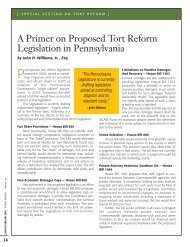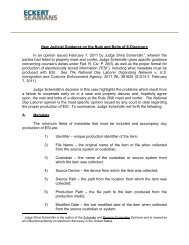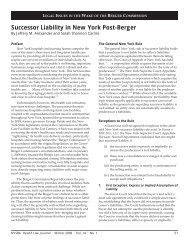2012 PROFESSIONAL LIABILITY UPDATE - Eckert Seamans
2012 PROFESSIONAL LIABILITY UPDATE - Eckert Seamans
2012 PROFESSIONAL LIABILITY UPDATE - Eckert Seamans
Create successful ePaper yourself
Turn your PDF publications into a flip-book with our unique Google optimized e-Paper software.
Pa. Cons. Stat. § 7101 et seq., and policy issues related to mental health care. Writing for themajority, Justice Cappy set forth the limitations for the duty to warn:Id. at 1043.In summary, we find that in Pennsylvania, based upon the specialrelationship between a mental health professional and his patient,when the patient has communicated to the professional a specificand immediate threat of serious bodily injury against a specificallyidentified or readily identifiable third party, and when theprofessional determines, or should determine under the standardsof the mental health profession, that his patient presents a seriousdanger of violence to the third party, then the professional bears aduty to exercise reasonable care to protect by warning the thirdparty against such danger.The Emerich court concluded that the requisite psychiatrist-patient relationship existedand that the psychiatrist knew or should have known that the patient was a serious threat to thespecific third party because of a specific threat to kill, thereby creating a duty to warn the nonpatient.The court concluded that the defendant psychiatrist discharged his duty by specificallywarning the non-patient third party to stay away from an apartment after the patient told thepsychiatrist earlier that day of a specific intent to kill the third party when she returned to theapartment to pick up her clothes. The third party disregarded the psychiatrist’s advice and wasshot by the patient when she went to the apartment.The issue of privity has presented itself to the Federal Courts. In Collins v. Christie, No.06-4702, 2007 U.S. Dist. LEXIS 61579 (E.D. Pa. Aug. 22, 2007), Plaintiff, a nursing assistant,was arrested after an elderly patient at a nursing facility falsely accused him of abuse. By way ofbackground, after the accusation was made, the patient underwent x-rays at a hospital. A doctorat the hospital misinterpreted the patient’s x-rays as showing newly fractured ribs, when in factthey revealed old, healed fractures. As hospital protocol required, the doctor reported hisfindings to the police. Plaintiff was subsequently arrested. Plaintiff sued the hospital and thedoctor, amongst others, for breach of a “[d]uty of due care to provide true and accurateinformation and diagnosis to the police.” The court held that the social utility in physiciansreporting elder abuse outweighs the foreseeable harm of an erroneous report. Accordingly, thecourt found that the hospital and doctor did not owe a duty of care to plaintiff with regard toreporting the abuse to the police.In DeJesus v. U.S. Department of Veterans Affairs, 479 F. 3d 271 (3d. Cir. 2007),Plaintiffs filed suit after decedent killed his two children, two neighborhood children, and thenhimself. Decedent had voluntarily entered the Veteran Affairs Domiciliary Program, where hewas diagnosed as having intermittent explosive disorder. He had a history of domestic violenceand had previously attempted to hang himself multiple times. Decedent received various mentalhealth treatments while at VA’s facilities, including medication, group therapy sessions and oneon-onecounseling.7









